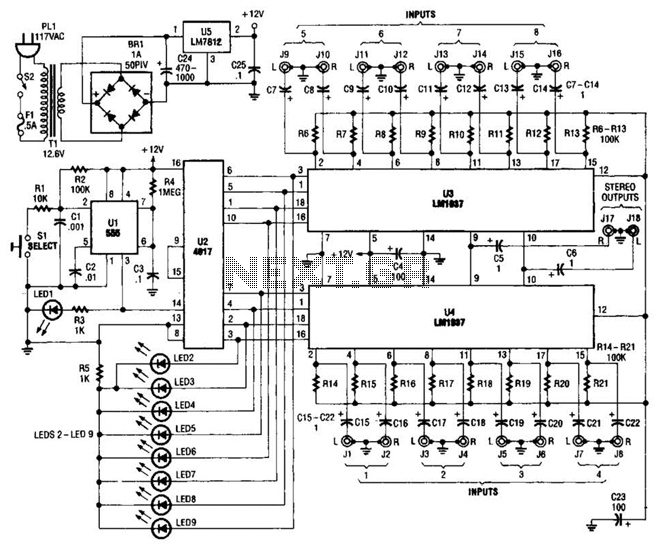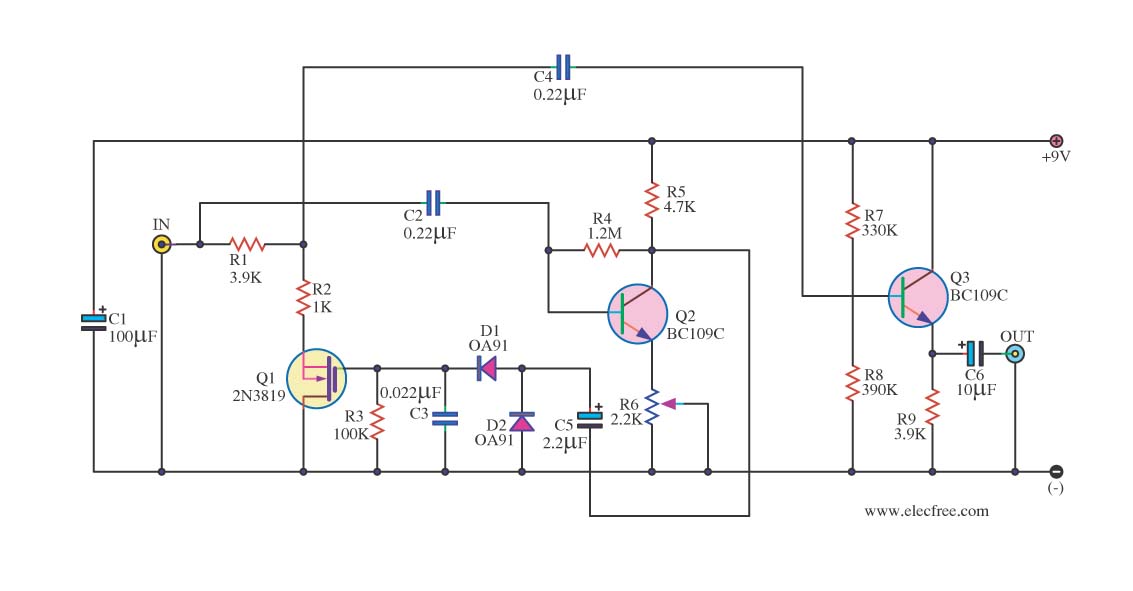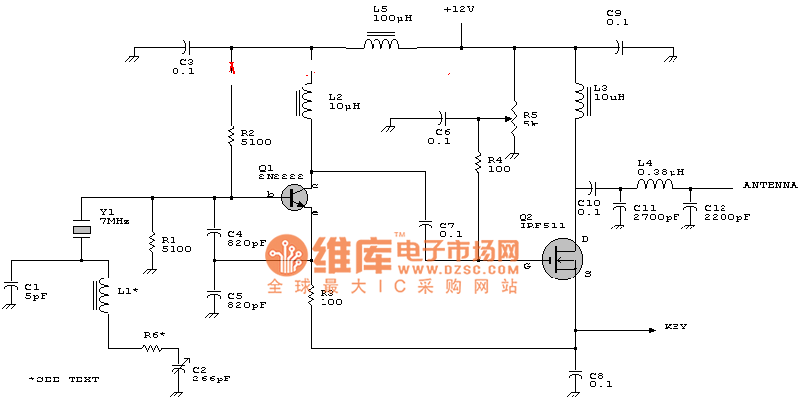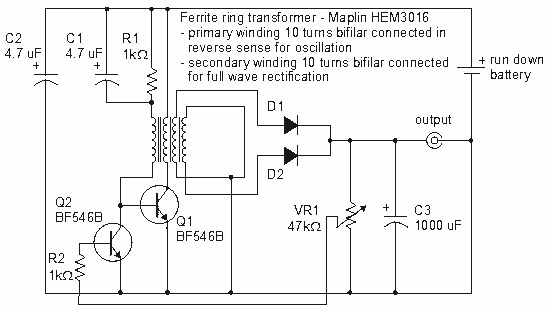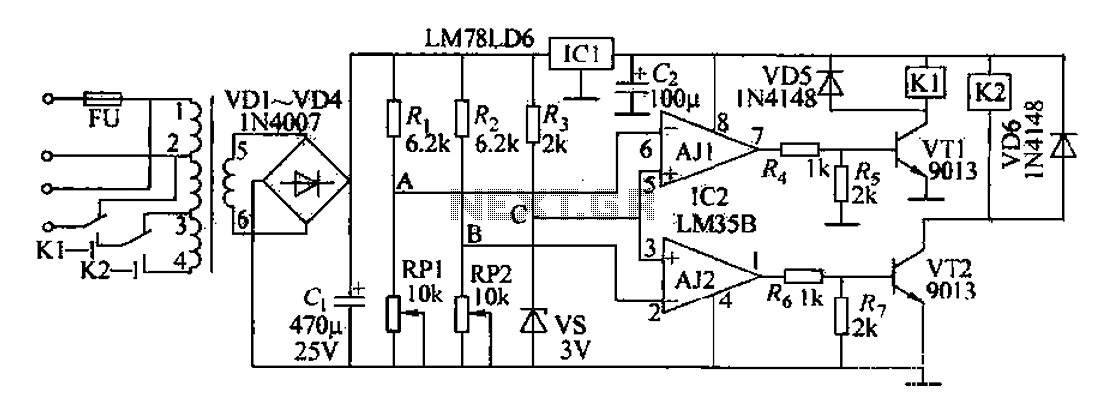
XR2212 PLL FM demodulator Circuit
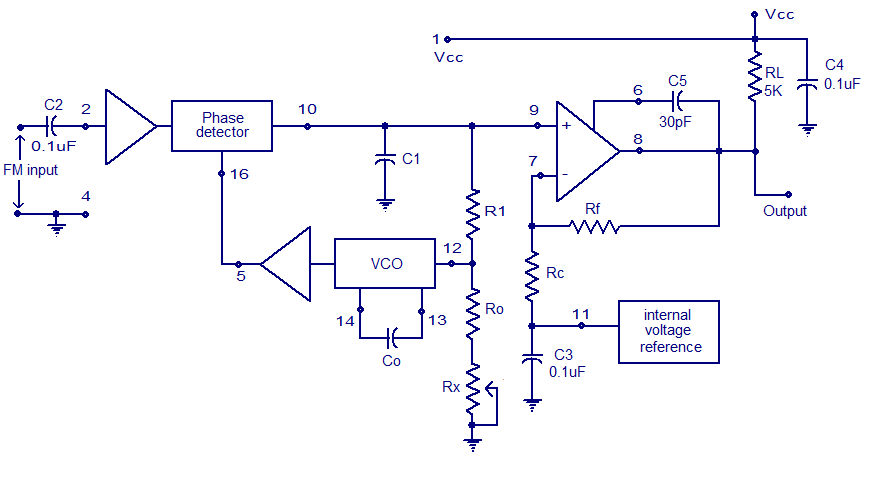
A simple PLL FM demodulator circuit using the IC XR2212 is presented. The XR2212 is a highly stable, monolithic PLL (phase-locked loop) IC specifically designed for communication and control system applications. It operates within a frequency range of 0.01 Hz to 300 kHz, with an operating voltage range of 4.5 to 20 V and a dynamic range of 2 mV to 3 Vrms. The IC also supports high temperature ranges, is compatible with TTL/CMOS, and features an adjustable tracking range. The operation of a PLL FM demodulator is straightforward. The input FM signal and the output from the VCO are fed into a phase detector circuit. The output from the phase detector is then filtered using a low-pass filter and amplified before being used to control the VCO. When there is no carrier modulation and the input FM signal is centered in the passband (i.e., only the carrier wave), the tuning voltage of the VCO is at its midpoint. When a deviation in the carrier frequency occurs (indicating modulation), the VCO frequency adjusts to follow the input signal in order to maintain the loop in lock. Consequently, the tuning voltage to the VCO varies, and this variation is proportional to the modulation applied to the FM carrier wave. This voltage variation is subsequently filtered and amplified to yield the demodulated signal.
The PLL FM demodulator circuit utilizing the XR2212 integrates several key components that work in unison to achieve effective frequency demodulation. The phase-locked loop architecture consists of a voltage-controlled oscillator (VCO), a phase detector, and a low-pass filter. The VCO generates a frequency that is locked to the incoming FM signal, ensuring that any changes in the frequency of the FM signal are tracked accurately.
The phase detector compares the phase of the incoming FM signal with the output from the VCO. When these two signals are in phase, the output of the phase detector is minimal, indicating that the loop is locked. However, when the frequency of the FM signal deviates due to modulation, the phase detector produces an output that corresponds to this deviation. This output is then processed through a low-pass filter, which removes high-frequency noise and allows only the desired modulation signal to pass through.
The filtered signal is then amplified to a suitable level for further processing or output. The amplification stage is crucial, as it ensures that the demodulated signal maintains a sufficient amplitude for the next stage of the signal chain. The final output is a demodulated signal that accurately represents the original information encoded in the FM carrier wave.
In summary, the XR2212 PLL FM demodulator circuit effectively demodulates frequency-modulated signals by leveraging the principles of phase locking. The combination of the phase detector, low-pass filter, and voltage-controlled oscillator facilitates a robust and stable demodulation process, making this circuit an excellent choice for various communication and control applications.A simple PLL FM demodulator circuit using IC XR2212 is shown here. XR2212 is a highly stable, monolithic PLL (phase locked loop) IC specifically designed for communication and control system applications. The IC has 0. 01 Hz to 300KHz frequency range, 4. 5 to 20V operating voltage range, 2mV to 3Vrms dynamic range, high temperature range, TTL / CMOS compatibility and adjustable tracking range. The operating of a PLL FM demodulator is incredibly simple to know. The input FM signal and the output of the VCO is applied to the part detector circuit. The output of the part detector is filtered employing a low pass filter, the amplifier and then used for controlling the VCO. When there`s no carrier modulation and the input FM signal is in the center of the pass band (i. e. carrier wave only) the VCO`s tune line voltage are going to be at the middle position. When deviation in carrier frequency happens ( that means modulation occurs) the VCO frequency follows the input signal so as to keep the loop in lock.
As a result the tune line voltage to the VCO varies and this variation is proportional to the modulation done to the FM carrier wave. This voltage variation is filtered and amplified in order to get the demodulated signal. 🔗 External reference
The PLL FM demodulator circuit utilizing the XR2212 integrates several key components that work in unison to achieve effective frequency demodulation. The phase-locked loop architecture consists of a voltage-controlled oscillator (VCO), a phase detector, and a low-pass filter. The VCO generates a frequency that is locked to the incoming FM signal, ensuring that any changes in the frequency of the FM signal are tracked accurately.
The phase detector compares the phase of the incoming FM signal with the output from the VCO. When these two signals are in phase, the output of the phase detector is minimal, indicating that the loop is locked. However, when the frequency of the FM signal deviates due to modulation, the phase detector produces an output that corresponds to this deviation. This output is then processed through a low-pass filter, which removes high-frequency noise and allows only the desired modulation signal to pass through.
The filtered signal is then amplified to a suitable level for further processing or output. The amplification stage is crucial, as it ensures that the demodulated signal maintains a sufficient amplitude for the next stage of the signal chain. The final output is a demodulated signal that accurately represents the original information encoded in the FM carrier wave.
In summary, the XR2212 PLL FM demodulator circuit effectively demodulates frequency-modulated signals by leveraging the principles of phase locking. The combination of the phase detector, low-pass filter, and voltage-controlled oscillator facilitates a robust and stable demodulation process, making this circuit an excellent choice for various communication and control applications.A simple PLL FM demodulator circuit using IC XR2212 is shown here. XR2212 is a highly stable, monolithic PLL (phase locked loop) IC specifically designed for communication and control system applications. The IC has 0. 01 Hz to 300KHz frequency range, 4. 5 to 20V operating voltage range, 2mV to 3Vrms dynamic range, high temperature range, TTL / CMOS compatibility and adjustable tracking range. The operating of a PLL FM demodulator is incredibly simple to know. The input FM signal and the output of the VCO is applied to the part detector circuit. The output of the part detector is filtered employing a low pass filter, the amplifier and then used for controlling the VCO. When there`s no carrier modulation and the input FM signal is in the center of the pass band (i. e. carrier wave only) the VCO`s tune line voltage are going to be at the middle position. When deviation in carrier frequency happens ( that means modulation occurs) the VCO frequency follows the input signal so as to keep the loop in lock.
As a result the tune line voltage to the VCO varies and this variation is proportional to the modulation done to the FM carrier wave. This voltage variation is filtered and amplified in order to get the demodulated signal. 🔗 External reference
